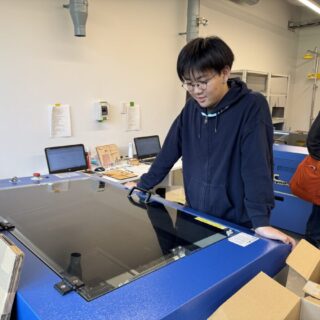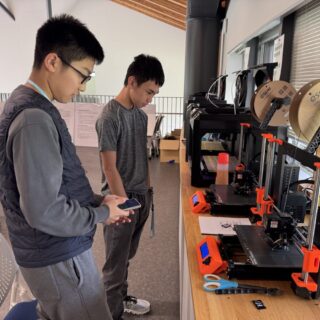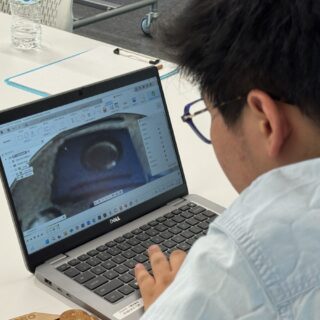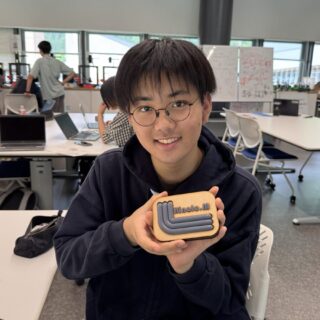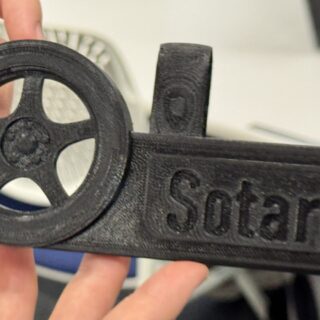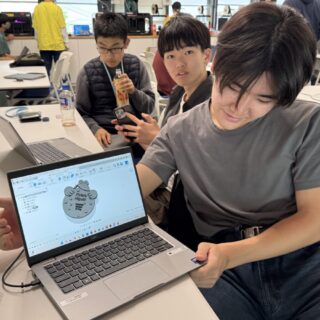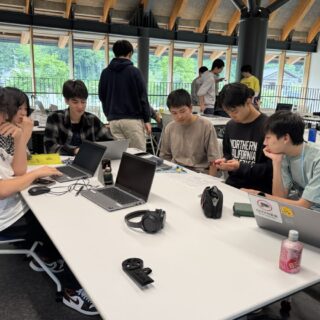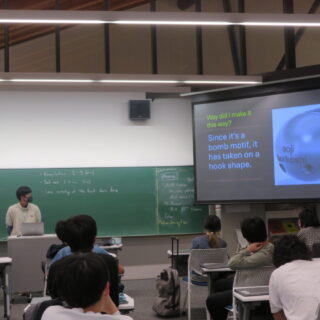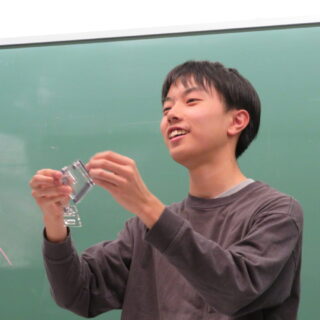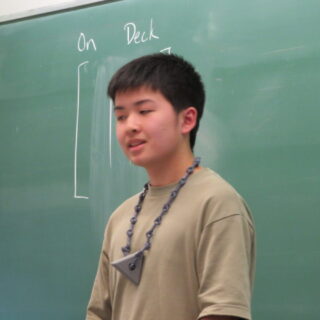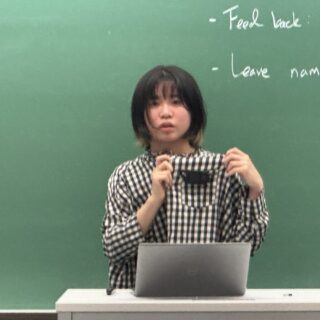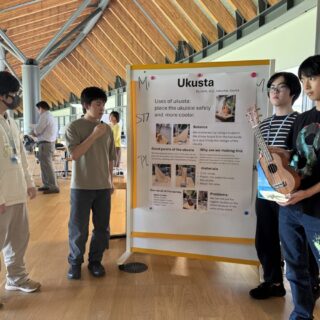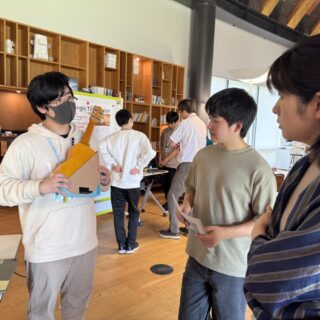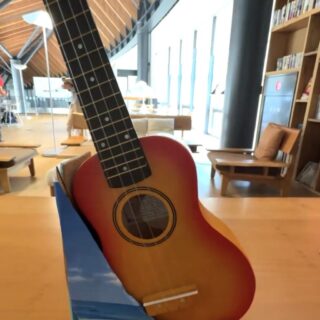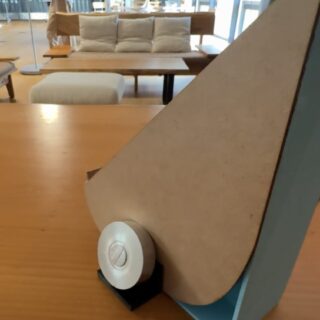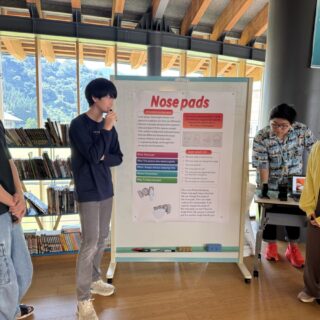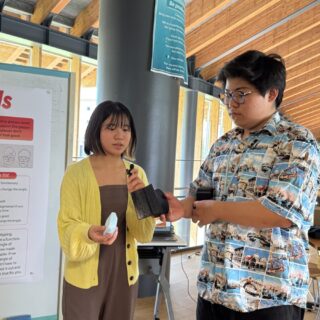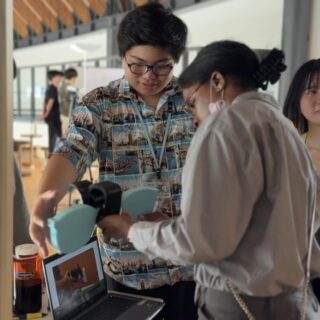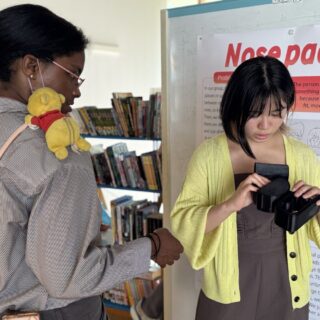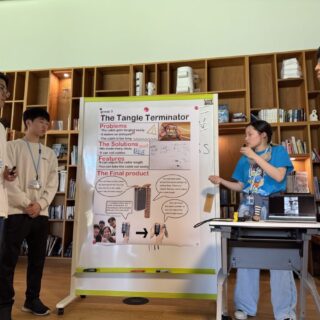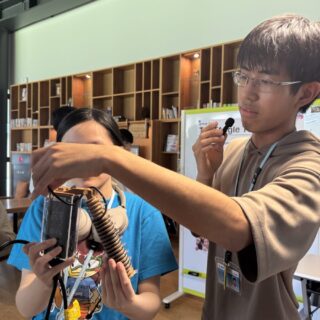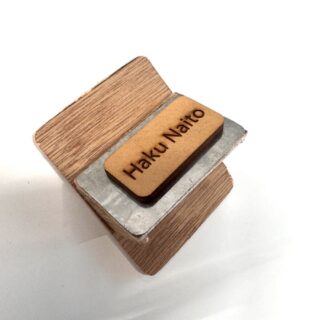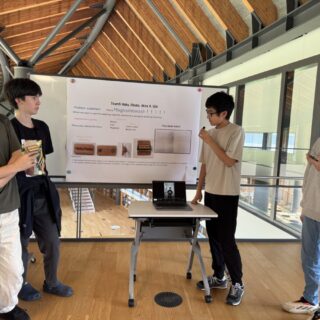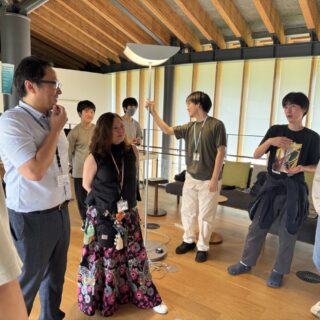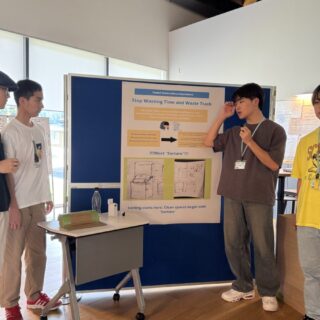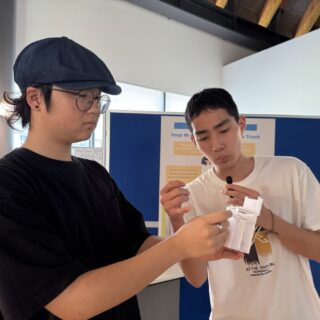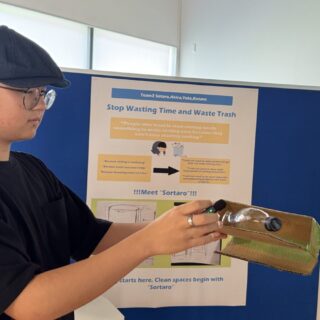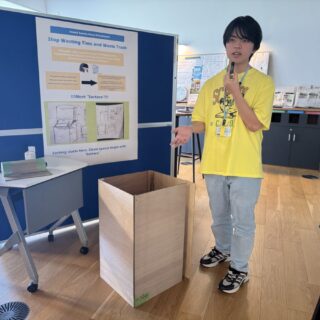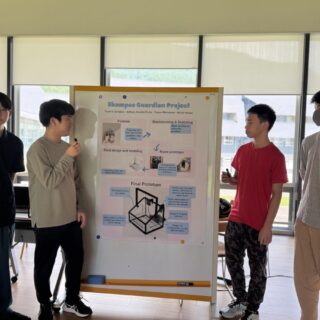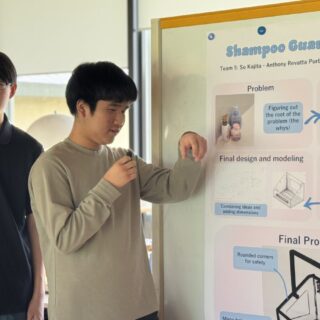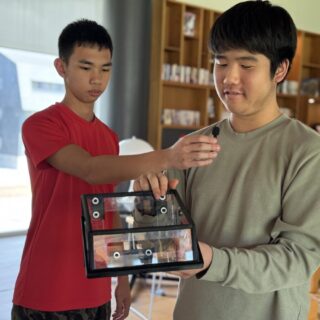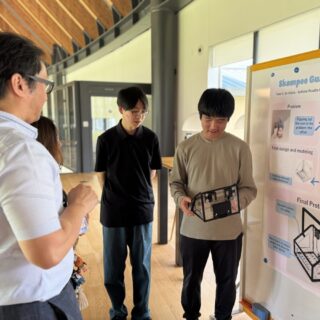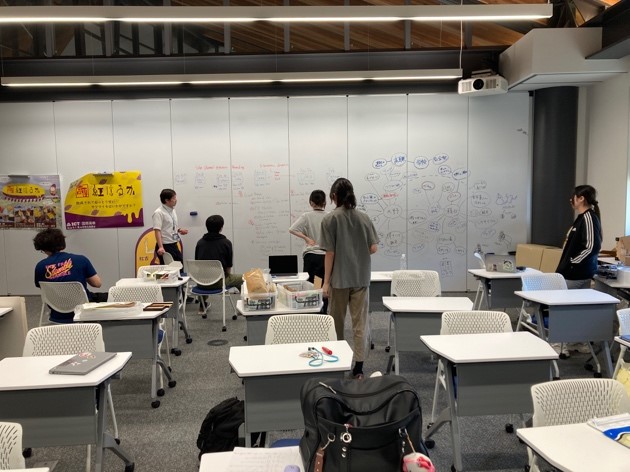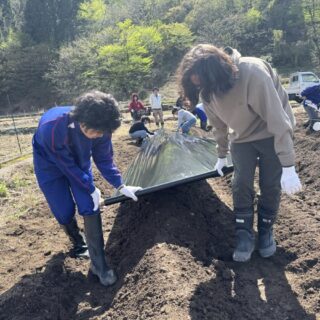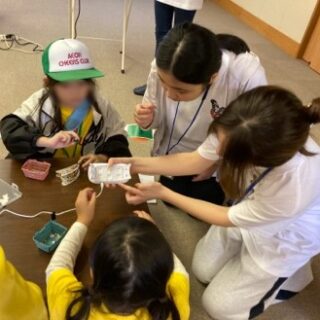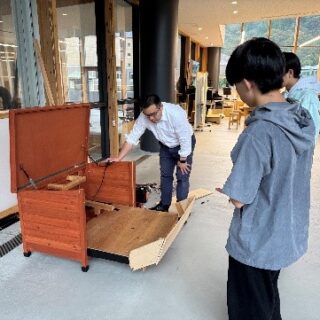Engineering Design (ED)
エンジニアリングデザイン(ED)
プロジェクト1:ネームタグ制作
こんにちは。白山麓キャンパスで1年生のエンジニアリングデザインを担当しているブランドン・ウォルファースです。国際高専のエンジニアリングデザインの授業では、学生たちが多様なプロジェクトに取り組みますが、デザインプロセスへの「導入」として、最初のプロジェクト「個性を表現するネームタグの制作」に挑戦しました。
このプロジェクトにはいくつかの条件がありました。ネームタグは着用可能であること、指定されたサイズ内に収まること、白山麓キャンパスにある3Dプリンターやレーザーカッターを使用して制作すること、そして制作者本人の特徴を視覚的に表現することが求められました。
学生たちはアイデアの発想から始まり、プロトタイピング(試作品作り)を通じて、特徴と機能の関係性について学びました。プロジェクトの締めくくりには、英語でのプレゼンテーションを行い、クラスメートに自作のネームタグを紹介しました。
エンジニアリングデザインの魅力は、テストやクイズとは異なり、問題解決に「唯一の正解」が存在しない点です。学生たちがそれぞれの方法で課題に取り組む様子は非常に興味深く、多くの学生が自身の趣味や好きなメディアをテーマにすることで、作品に個性を反映させていました。これは学生たちにとって初めてのデザイン体験であり、今後の成長が非常に楽しみです。
プロジェクト2:チームによる課題解決
前学期の後半には、1年生はチームプロジェクトにも取り組みました。このプロジェクトの目的は、学生が日常生活を観察し、「毎日使っている中で最も不便なもの」を特定し、それに対する個人的な課題を解決する方法を考案することです。
この活動で特に興味深いのは、学生たちが日常の中でどのような不便さを認識し、それにどう向き合うかという点です。各グループが取り組んだ課題は多様でしたが、共通して求められたのは、「対象物の使用方法の理解」「目的の機能を果たすために必要な特徴の把握」、そして「人間中心の設計の重要性」でした。
以下に、各グループの取り組みをご紹介します。
1. Ukusta(ウクスタ)
このグループは、白山麓キャンパスのリビングコモンズにあるウクレレのための新しいスタンドの設計に挑戦しました。楽器の安定性を高めるとともに、空間の美観を向上させることを目指しました。
2. Nosepads(ノーズパッド)
このグループは、さまざまな眼鏡やサングラスに対応できる調整可能なノーズパッドの開発に取り組みました。鼻の形状に合わせてフィットするよう設計されており、試作品はサイズの関係上、拡大モデルでの提示となりました。
3. The Tangle Terminator(タングル・ターミネーター)
このグループは、ノートパソコンの充電ケーブルがバックパック内で絡まりやすいという問題に着目し、収納性を向上させるための整理ツールを考案しました。持ち運びの利便性を重視した設計です。
4. Magnamewash(マグネームウォッシュ)
このグループは、白山麓キャンパスの寮にあるランドリー設備の利用状況を整理する方法を模索しました。誰がどの機械を使用しているかを簡単に把握できる、設置・使用が容易で情報伝達が明確な仕組みを目指しました。
5. Sortaro(ソルタロウ)
このグループは、ごみの分別が複雑で時間がかかるという問題に取り組みました。日本の分別システムに慣れていない人でも使いやすく、適切に分別できる一体型のごみ箱の設計を目指しました。
6. Shampoo Guardian Project(シャンプー・ガーディアン・プロジェクト)
このグループは、寮のシャワー室における収納スペースの不足に着目しました。シャワー中に使用するボトル類を簡単に持ち運び、アクセスできる収納ツールの開発に取り組みました。
後学期に学生たちがどのようなプロジェクトに挑戦するのか、今から非常に楽しみにしています。
ブランドン・ウォルファース

Project 1:Creating Name Tags
Hello everyone, this is Brandon Wohlfarth, one of the Engineering Design teachers for the 1st year students. Within our Engineering Design course here at ICT, students get the chance to work on a wide range of projects, but to help “introduce” the students to the design process, their first project was to create individualized nametags.
There were some criteria that the students needed to follow during the project: their nametag needed to be able to be worn, it needed to fit within a certain volume, it needed to be made using the 3D printers and/or laser cutters that we have here at Hakusanroku Campus, and it needed to visually show important characteristics about the designer.
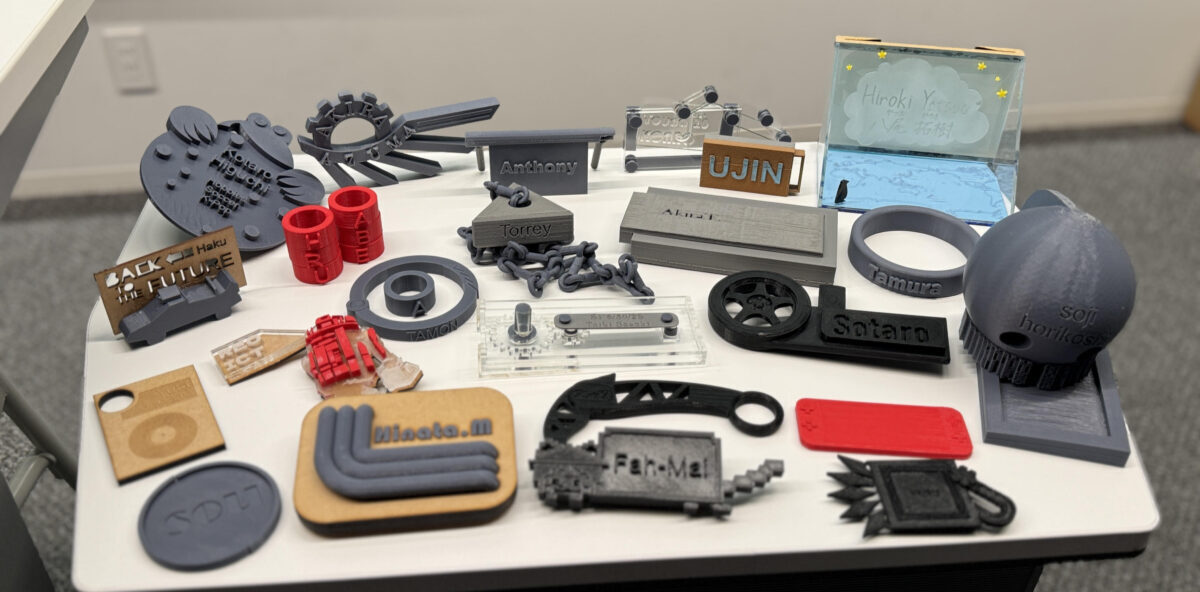 During this project students walked through how to come up with ideas, practiced prototyping, and learned about the connections between features and functions. This project culminated in a presentation where the students were able to “introduce” their nametags to their classmates, and practice their English-speaking skills.
During this project students walked through how to come up with ideas, practiced prototyping, and learned about the connections between features and functions. This project culminated in a presentation where the students were able to “introduce” their nametags to their classmates, and practice their English-speaking skills.
What I enjoy the most about Engineering Design is that, unlike tests and quizzes, there isn’t just one right answer to how to solve the problem. It was very interesting to see how the students decided to approach the challenge ahead of them. Many students focused on creating something that helped introduce their hobbies, or maybe a certain source of media that they enjoyed, allowing them to add parts of their personality into their final creation. This is just the first design experience for the students, so I am looking forward to where they go from here.
Project 2:Solving Problems through Teamwork
Within the first semester the first-year students also worked on a team project in Engineering Design IA. The goal of this project is for students to observe the world around them and identify the “Worst thing that they use everyday” and try to find a solution their individual pain points regarding the topic selected. An aspect of this project that I enjoy seeing is how students perceive and approach different challenges or inconveniences that they experience in their daily life. Each group tackled a very different problem, but they still needed to understand how an object is used, what are important features needed to complete a desired function, and a little about how people are an important part in designing a new product. We always get some interesting projects when we do this activity, so I am excited to share them all with you.
1. Ukusta
This group decided to take on the challenge of designing a new stand for the ukuleles found in the Living Commons at the Hakusanroku Campus. They wanted to make something that would stabilize the instrument while also helping to improve the visual aesthetics of the space.
2. Nosepads
This group decided to devise an adjustable attachment that could fit with various glasses or sunglasses, in order to help match the shape and contour of different noses. Due to the size that this type of attachment would need to be, for demonstration purposes only, their prototype was an enlarged version of their design.
3. The Tangle Terminator
This group decided to envision a way to help organize their laptop charging cables to improve upon its ability to be stored inside of a backpack, as most students do. They found that inside of the backpack, the cables tended to become tangled easily, which lead them to address this issue within the scope of portability.
4. Magnamewash
This group wanted to find a way to help organize the use of the laundry facilities within the Hakusanroku Campus dormitories. They wanted to help solve the issues of not knowing who is using what machine in an easy to install, easy to use way that would transfer information quickly and clearly.
5. Sortaro
This group found that sorting trash can be a difficult and time-consuming activity, and as someone who even after years of living in Japan still has challenges understanding this system I can relate. They wanted to make something that would still properly sort various types of garbage, but be in one easy to use location.
6. Shampoo Guardian Project
This group wanted to address the lack of shelving space within the showers at the Hakusanroku Campus dormitory. They wanted something that could be used within the shower stalls on campus, that was easy to carry and to access the various bottles that they wanted to use while showering.
I am looking forward to what they do in the second semester!
Brandon Wohlfarth
こんにちは。エンジニアリングデザインⅡ(2年生)を担当している小髙 有普です。本校では、地域と連携した実践的な学びを重視しています。エンジニアリングデザインⅡでは、地域の農業課題に取り組みながら、技術とビジネスの両面から解決策を考える授業を行っています。テック班は芋を守るための獣害対策を技術的に支援し、ビジネス班は守られた芋を地域ブランド芋として販売することで地域活性化を目指します。
この授業で学生たちに求められることは、現状を正しく理解をしたうえで、地域活性の新たな方法を見出し、実現するための設計目的を持つことです。そのため、この地域で栽培する意味や効果、栽培に必要なものや労力などを多角的に理解する必要があります。そこでまずはクラス全員で、畝作り、植え付け、獣害対策用の電気柵設置を行いました。
2025年5月26日 鹿田校長先生のジャーナル「紅はるか苗植え」
-
Identifying current issues and brainstorming ideas by Business Teamビジネス班による現状の洗い出しとアイデア検討の様子
-
Installation of electric fences for wildlife protection電気柵取り付けの様子
今年は4月半ばにもかかわらず、畑には50センチ以上の雪が残っており、気温も上がらず、苗を植えることは難しい状況でしたが、奇跡の長雨により雪が解け、注文していた苗の納品時期に植え付けができました。しかし、今年の春の気温は10度前半で寒く、発根、成長には適温ではなく、苗は元気がない状況で心配しました。5月に入り、ようやく気温も上昇し始め苗の成長が見られるようになり、ほっとしました。
苗が活着した後も時々苗の様子を見に行っていたのですが、今年は苗が抜けているという事態が起こっていました。ネットで調べたところ、植え付け直後の苗は、カラスにとって格好の餌となるとのことが事例として挙げられており、本校の畑も同じことが起こっているのかもしれません。また、ワイヤーメッシュをポールに結束するための針金に電気柵が引っかかって弛んでいる状況もありました。来年は植え付け後に畑で何が起こっているのか、カメラを設置し注意深く観察する必要がありそうです。今年も芋販売をしますので、とびきり甘い高専紅はるかをご堪能ください。
小髙 有普
Hello, this is Arihiro Kodaka, and I am in charge of Engineering Design II for 2nd year students. At ICT, we place great importance on practical learning in collaboration with the local community. In Engineering Design II, students tackle agricultural challenges faced by the region and explore solutions from both technological and business perspectives. The Tech Team provides technical support for wildlife damage prevention to protect sweet potatoes, while the Business Team works to revitalize the community by marketing the protected sweet potatoes as a local brand product.
In this class, students are expected to accurately understand the current situation, identify new approaches to revitalizing the local community, and establish clear design objectives to realize those ideas. To achieve this, it is essential for them to gain a multifaceted understanding of the significance and impact of cultivating crops in this region, as well as the resources and effort required. As a first step, the entire class participated in creating ridges in the field, planting sweet potatoes, and installing electric fences to prevent wildlife damage.
Please also refer to the Hakusanroku Journal written by President Maasaki Shikada,
“2nd Year Engineering Design: Beniharuka Sweet Potato Planting (May 26th, 2025)"
-
Identifying current issues and brainstorming ideas by Business Teamビジネス班による現状の洗い出しとアイデア検討の様子
-
Installation of electric fences for wildlife protection電気柵取り付けの様子
Although it was already mid-April this year, more than 50cm of snow remained in the field, and the temperatures were still low, making it difficult to plant the seedlings. However, thanks to a miraculous period of continuous rain, the snow melted just in time for the scheduled delivery of the seedlings, allowing us to proceed with planting. However, the temperatures this spring were in the low 10℃, which was quite cold and not ideal for root development or growth. The seedlings didn’t look very healthy, and I was worried. Fortunately, in May, the temperatures finally started to rise, and I was relieved to see the seedlings beginning to grow.
Even after the seedlings had taken root, we continued to monitor their condition. This year, I noticed that some seedlings had been pulled out. Upon researching online, we found reports indicating that newly planted seedlings can be an easy target for crows, which may be what happened in our field as well. Additionally, we observed that the electric fence had become loose due to the wire mesh getting caught on the binding wire used to secure it to the poles. Next year, we plan to install a camera to closely monitor what happens in the field after planting. We will be selling sweet potatoes again this year, so please enjoy our exceptionally sweet Kosen Beniharuka!
Arihiro Kodaka
 こんにちは。校長の鹿田 正昭です。
こんにちは。校長の鹿田 正昭です。
 2025年4月24日(木)、今回で3回目の参加となる、エンジニアリングデザインⅡ(2年生)「紅はるか」の苗植えをお手伝いしました。今回は金沢キャンパスで会議があったため、会議終了後に白山麓キャンパスに移動し、到着した頃にはすでに畝が完成し、植え付けが始まっていました。今年は西側から2列目を半分ほど植えました。今冬は雪が多かったため土がかなり湿っている感じでしたが、この方が作業を進めやすいと感じました。
2025年4月24日(木)、今回で3回目の参加となる、エンジニアリングデザインⅡ(2年生)「紅はるか」の苗植えをお手伝いしました。今回は金沢キャンパスで会議があったため、会議終了後に白山麓キャンパスに移動し、到着した頃にはすでに畝が完成し、植え付けが始まっていました。今年は西側から2列目を半分ほど植えました。今冬は雪が多かったため土がかなり湿っている感じでしたが、この方が作業を進めやすいと感じました。
苗植えは3回目となりましたが、慣れてきたとはいえやはり自分の植えた苗が収穫時にうまく育っているか気になります。一昨年は雨が多かったせいか、あまり大きな芋の収穫はできませんでした。昨年は天候も良く、適度な雨だったため大きな芋が育ちました。今年も昨年同様な出来具合を期待したいと思います。
2年生全員とエンジニアリングデザインⅡ担当の先生方、ラーニングメンターのアブワン兄妹も参加して午後4時前に苗付けを完了しました。そして電気柵の設置や獣害対策が施され、今年も昨年に引き続いての豊作を期待したいと思います。
本校では11月1日(土)、2日(日)にオープンキャンパスを開催します。これに合わせて恒例の焼き芋販売が「道の駅瀬女」で行われる予定です。お時間があれば、ぜひ「道の駅瀬女」まで足を伸ばしてみてください。
オープンキャンパス詳細はこちら
鹿田 正昭
Hello. I am Masaaki Shikada, ICT President.

On Thursday, April 24th, 2025, I helped plant Engineering Design II's "Kosen Beniharuka" seedlings for the third time. This time, I had a meeting at Kanazawa Campus, so I couldn’t travel to Hakusanroku Campus until after the meeting ended. By the time I arrived, the ridges had already been prepared and the planting had begun. This year I planted the second row from the west side. The soil was quite wet this winter due to the heavy snowfall, but I felt this made the work easier.
This is the third time I have planted seedlings, and although I am getting used to it, I still worry about whether the seedlings I planted will grow well. The year before last, the potatoes did not grow very large, probably because it rained a lot. Last year, good weather and moderate rainfall resulted in large potatoes. We expect this year's crop to be as good as last years.
All 2nd year students, Engineering Design II teachers, and Learning Mentors Domyson Abuan sensei and Sharmee Abuan sensei joined us to complete the seedling planting before 16:00. Then electric fences were installed and measures were taken to prevent damage from animals. We hope for another good harvest this year, following on from last year.
Our school will hold an open campus on Saturday, November 1st and Sunday, November 2nd. In conjunction with this event, the annual baked sweet potato sale will be held at the Sena Road Station. If you have time, please visit the Sena Road Station and try some potatoes!
Click here for more details about Open Campus
Masaaki Shikada

こんにちは。白山麓高専事務室の間加田 侑里です。今回、2025年1月28日(火)に行われたエンジニアリングデザインⅡB(2年生)の最終発表について紹介します。
エンジニアリングデザインⅡBの授業では、白山麓地域の社会環境、自然環境、産業環境をテーマとした課題解決型プロジェクトに取り組み、学生たちは「アグリビジネス班」と「テック班」に分かれて活動しています。両チームが取り組んできた活動について紹介します。
【アグリビジネス班の活動】
アグリビジネス班は主に、アサギマダラマーキングイベント、焼芋販売、人形浄瑠璃といった白山麓の地域活性化活動を行ってきました。アグリビジネス班は地域住民と交流を図り、イベント企画やディスカッションを通して、観光資源を有効活用し地域活性化に繋げていくことを目標としています。
アサギマダラマーキングイベント
白山麓キャンパス前の休耕田では、アサギマダラが集まるようにフジバカマの栽培が行われています。アグリビジネス班は、飛来するアサギマダラを地域の貴重な資源とし、地域活性化につなげるプロジェクトに取り組みました。
今年も尾口まちづくり協議会、白山ろく里山活性化協議会およびアサギマダラファンクラブが運営する「アサギマダラマーキングイベント」が開催され、アグリビジネス班はイベントに協力する形で参加しました。マーキング体験は事前予約制の30名限定で行われ、学生たちはマーキング体験に加えて、予約してくれた30名の参加者が楽しめるイベントを企画し、白山麓の魅力を広めるとともに、地域住民と来訪者が交流できる場を作ることを目指しました。
学生たちはイベント集客に向け、アサギマダラマーキングイベントの広告ポスターを作成し、「はくさん比咩の湯温泉」「尾口コミュニティセンター」「道の駅 瀬女」に掲示しました。また、フォトスポットや休憩スペースの設置、SNSでの宣伝や観察場所の確保、アサギマダラグッズ販売、レーザーカッターを用いたキーホルダー作り体験、カプセルトイの設置などを行いました。特にカプセルトイは想像以上に人気があり、多くのお客様にも楽しんでいただけたようです。
詳細は2年生のエンジニアリングデザイン科目担当の小髙 有普先生執筆「アサギマダラのマーキングイベントの運営に参加」をご覧ください。
-
Commemorative photo shootフォトスポットで記念撮影の様子
-
Creation of original goodsオリジナルグッズ作成の様子
-
Capsule toy machineカプセルトイ
-
Keychain-making experience using a laser cutterレーザーカッターを用いたキーホルダー作り体験
高専紅はるか焼芋販売
アグリビジネス班は、白山ろく里山活性化協議会のご協力のもと、白山麓キャンパス前の休耕田を活用し、前学期から「高専紅はるか」の栽培に取り組みました。学生たちは、キジトラコーヒー研究所、道の駅瀬女と協力し、学生たちが自ら栽培した「高専紅はるか」を販売することで地域活性化を目指しました。
今年も国際高専とのコラボ商品としてキジトラコーヒー研究所で、高専紅はるかを使用した「チップスべにゃソフト」と「べにゃソフト」を、道の駅瀬女では「紅はるかサンデー」と「高専紅はるか」の生芋が販売されました。
-
Chips Benya Softチップスべにゃソフト
-
Beniharuka Sundae紅はるかサンデー
-
Fresh Kosen Beniharuka sweet potatoes「高専紅はるか」の生芋が販売
さらに、11月3日(日)および4日(月)の2日間、道の駅瀬女店頭で、アグリビジネス班が「高専紅はるか」の焼芋販売を行いました。昨年度は高専紅はるかブランドの浸透とファン作りを目的に、4種類の「高専紅はるか」マスコットキャラクターを用いたオリジナルグッズとしてキーホルダーとマグネットを制作し、「高専紅はるか」の焼芋を一定額以上購入された方にカプセルトイとして無料で配布され、今年度は、昨年度の先輩達が制作したキャラクターグッズを継承しながら、新たにアクリルスタンドを追加しました。
また、今年はさつまいも「高専紅はるか」の生育が良く、収穫量は昨年度に比べ約1.6倍となったことから、その分、より多くのさつまいもを売らなければいけませんでした。そのため今年度は、より広くブランド周知の展開を図ることと、キジトラコーヒー研究所と道の駅 瀬女での販売促進を目指し、それぞれの店舗で販売されている高専紅はるか関連商品を一定額以上購入された方にもカプセルトイ無料交換券を配布しました。
昨年度は30個程度のカプセルトイが配布されましたが、今年はキジトラコーヒー研究所や道の駅 瀬女からも多くのお客様に焼芋屋台にお越しいただき100個のカプセルトイを配布できました。お客様の中には、またカプセルトイが欲しいからと、別の商品を買いに来られた方や、昨年に引き続き、「今年も焼き芋を楽しみに来た」と声をかけてくれるお客様もいらっしゃいました。そして最終的な売上は、昨年度に比べ約1.4倍となり、昨年度以上の売上を目指して活動してきた学生たちの目標も達成することができたようです。
東二口文弥人形浄瑠璃
東二口文弥人形浄瑠璃は、文楽の前に流行した古浄瑠璃・文弥節を受け継いでいます。現在、文弥人形浄瑠璃が継承されているのは、日本で4箇所のみとなっており、そのうちの一つが石川県白山市 東二口地区に現存しています。かつての村の有志が京都で習い覚えたものを伝え、350年以上にわたり、継承されてきました。今もなお当時の趣のままに残っています。
この東二口の文弥人形浄瑠璃をより多くの人に知ってもらい楽しんでもらうことを目的とし、学生たちは文弥人形浄瑠璃の公演会場である東二口歴史民俗資料館へ出向き、インタビューを通じて、感じたことや課題をもとに活動を進めました。
そこで学生たちは人形浄瑠璃を盛り上げるために2つのイベントを企画しました。
1つ目は、ペーパークラフトを使って人形浄瑠璃の魅力を伝えるというものです。ペーパークラフトを現地で公演会に訪れた方々へのおみやげにして持ち帰れるようにしたり、ホームページからダウンロードできるようにしたりし、自宅でも楽しめるアイデアを提案しました。
2つ目は、チラシの配布を白山市内の公共施設以外にも広げ、ポスターでの宣伝を提案しました。その結果、冬でもウィンタースポーツを楽しみに来られる観光客の多い「道の駅 瀬女」や「一里野地域」でもチラシ配布が可能になりました。さらに、保存会会員の方々との話し合いをもとに、現状の取り組み等をまとめた現状分析マップを作成しました。
今回の活動では、ペーパークラフトで新たな体験の可能性を模索したり、東二口文弥人形浄瑠璃の現状を可視化にしたりし、様々な視点から課題に気づくことができる機会が作れたのではないでしょうか。学期末の活動となり十分な時間を確保することが難しい時期となってしまいましたが、今後は、保存会の方々と、未来のあり方を共に考えながら活動していくことが重要だと感じたそうです。
【テック班の活動】
「テック班」は獣害対策のために、AIやIoTなどの技術を活用した害獣監視および通知システム、害獣を威嚇するためのドローン制御等を中心とした技術開発に取り組んでいます。
白山麓では猿による農作物への被害が年々深刻化しています。これまでにテック班は猿を撃退するために、AIを活用した猿監視システムの認識精度を90%以上に向上させ、猿を認識した際に生産者のLINEへ通知を送る機能の開発や、ドローンによる威嚇効果の検証を行ってきました。
今年度は畑を守る新たな手段として、悪路を走行できる見回りロボット(ローバー)を開発するローバー班とドローンの自動離着陸精度の検証を行うドローン班、ドローンのために畑の雨量や風速を確認するシステム開発を行うIoT班の3つのグループに分かれて課題解決に取り組みました。
ローバー班
ローバー班は畑の天候によってはドローンを飛ばせないという問題に対して、悪天候でも畑を見回り、猿を威嚇できるようなローバーの開発に今年度から新しく取り組みました。最終的な目標は自動で畑を動き回ることですが、まずは畑の上という不整地を走行可能な車体の完成を目指しました。学生たちはローバーを作るにあたって、どれぐらいのスピードで畑を移動させたいか、どれぐらいの大きさ・重量で作りたいか、という「どんなローバーにしたいか」のアイデアをもとに詳細な設計を進め、使用する部品を決めていきます。
完成したローバーは実際に畑の上で走行テストを行う予定でしたが、畑は大量の雪で覆われていたため学内のコンクリートやアスファルト、うっすらと雪が積もった芝生の上で走行テストを行いました。
猿をどのように威嚇するか、どのように畑を自動走行させるかという2点は来年度以降の課題となります。
-
Discussing ideas for roversローバーについてディスカッション
-
Rover developmentローバーの開発
-
Rover developmentローバーの開発
-
On campus test over concrete, asphalt, and grass with a light dusting of snowうっすらと雪が積もった芝生の上で走行テスト
ドローン班
今年度の目標は、ドローンのGPS精度の分析、ドローンの離着陸と猿を威嚇するためのドローン自動操縦の運用確認をすることでした。また、新たにドローン収容箱を製作・畑に設置し、ドローンの離着陸と収容が可能になりました。
開発したシステムの動作は次のようになっています。
1. AI猿監視システムが猿を認識すると、LINEの通知が畑の生産者(ユーザー)に送信される。
2. ユーザーは遠隔操作でドローン収容箱の扉を開ける。
3. ユーザーによる遠隔操作でドローンは自動的に離陸し、猿を威嚇するために畑を周回する。
4. ドローンは畑を周回後、収容箱に着陸する。
5. ユーザーは遠隔で収容箱の扉を閉める。
これを学内でテストしたところ、カフェテリアからの遠隔操作によるドローンの離着陸とドローン収納箱の一連の動作を確認できました。
-
Building a drone storage boxドローン収容箱を製作
-
Drone storage boxドローン収容箱
-
Testing the drone’s autonomous operationドローンによる自動操作の誤差を検証中
IoT班
ユーザーとAI猿監視システム、ドローン、ローバーの橋渡しをIoTを用いて行います。AI猿監視システムが畑で猿を認識すると、システムは畑の雨量、風速、猿の画像をユーザーに発信し、ユーザーはこの情報をもとにドローンやローバーが畑で運用できる状況かどうかを判断します。こうした機能の強化は、ロボットが拙速に判断を下さないようにするのに役立ちます。また、迅速なメンテナンスのために、システムがオフラインかどうか、インターネットが接続されているかどうか、どのカメラがオフラインかどうかをチェックするようソフトウェアを改良しました。
-
Confirmation of weather station operation昨年度組み立てたウェザーステーションの動作を確認している様子
-
Development of a new AI system to recognize monkeys猿を認識する新しいAIシステムを開発中
-
Development of a new AI system to recognize monkeys猿を認識する新しいAIシステムを開発中
間加田 侑里
 Hello, this is Yuri Makada from the Hakusanroku Office. This time, I would like to write about the Engineering Design IIB final presentation held on Tuesday, January 28th, 2025.
Hello, this is Yuri Makada from the Hakusanroku Office. This time, I would like to write about the Engineering Design IIB final presentation held on Tuesday, January 28th, 2025.
The Engineering Design IIB class, worked on problem-solving projects on the social, natural, and industrial environments of the HAKUSANROKU (Foothills of Mt. Hakusan) region. Students were divided into two teams, the Agribusiness Team and the Tech Team. I will introduce the activities that both teams have been working on.
Activities of the Agribusiness Team
The Agribusiness Team has been working on regional revitalization activities in HAKUSANROKU, including the Asagimadara (Chestnut Tiger Butterfly) marking event, roasted Kosen Beniharuka sweet potato sales, and traditional Ningyo Joruri (Puppet Theater).
Asagimadara (Chestnut Tiger Butterfly) Marking Event
In a fallow field in front of the Hakusanroku campus, Fujibakama flowers (boneset) are being cultivated to attract Asagimadara. The Agribusiness Team is working on a project to revitalize the community by making the migrating Asagimadara a valuable local resource.
This year, the Asagimadara Marking Event, organized by the Oguchi Community Development Council, the Hakusanroku Satoyama Revitalization Council, and the Asagimadara Fan Club, was held again. The Agribusiness Team participated in the event in a supporting role. The marking experience was limited to 30 participants by advance reservation, and in addition to assisting with the marking activity, the students planned events to ensure that the 30 participants could have a fuller experience. Their goal was to promote the charm of HAKUSANROKU while creating an opportunity for interaction between local residents and visitors.
To attract participants to the event, the students created promotional posters for the Asagimadara Marking Event and displayed them at Hakusan Himenoyu Onsen, Oguchi Community Center and Sena Roadside Station.
Additionally, they set up photo spots, observation areas, and rest areas, in order to promote the event on social media. They also organized various activities such as selling Asagimadara-themed merchandise, hosting a keychain-making experience using a laser cutter, and setting up a capsule toy machine. The capsule toy machine, in particular, was more popular than expected and made many visitors happy.
For more details, Arihiro Kodaka sensei, who is in charge of Engineering Design, has written about the Asagimadara Marking Event
-
Commemorative photo shootフォトスポットで記念撮影の様子
-
Creation of original goodsオリジナルグッズ作成の様子
-
Capsule toy machineカプセルトイ
-
Keychain-making experience using a laser cutterレーザーカッターを用いたキーホルダー作り体験
Kosen Beniharuka Sweet Potatoes Sales
The Agribusiness Team, with the cooperation of the Hakusanroku Satoyama Revitalization Council, has been cultivating Kosen Beniharuka sweet potatoes since first semester, utilizing a fallow field in front of the Hakusanroku campus. The students collaborated with the Kijitora Coffee Laboratory and Sena Road Station, aimed at revitalizing the local community by selling Kosen Beniharuka sweet potatoes that the students grew by themselves.
This year, as part of a collaboration with ICT, Kijitora Coffee Laboratory sold "Chips Benya Soft" and "Benya Soft" made with Kosen Beniharuka sweet potatoes, while Sena Road Station offered "Beniharuka Sundae" and fresh Kosen Beniharuka sweet potatoes for sale.
-
Chips Benya Softチップスべにゃソフト
-
Beniharuka Sundae紅はるかサンデー
-
Fresh Kosen Beniharuka sweet potatoes「高専紅はるか」の生芋が販売
Additionally, on Sunday, November 3rd and Monday, November 4th, 2024, the Agribusiness Team sold roasted Kosen Beniharuka sweet potatoes at the Sena Road Station store. Last year, with the aim of promoting the Kosen Beniharuka brand and building a fan base, original merchandise such as keychains and magnets featuring four mascot characters of Kosen Beniharuka were created. These were distributed for free as capsule toys to customers who purchased roasted Kosen Beniharuka sweet potatoes of a certain amount. This year, while inheriting the character goods created by last year's students, new acrylic standing figures were added to the collection.
This year, the Kosen Beniharuka sweet potato harvest was excellent, with the harvest volume approximately 1.6 times greater than last year. As a result, more Kosen Beniharuka sweet potatoes had to be sold. To promote the brand more widely and boost sales at both the Kijitora Coffee Laboratory and Sena Road Station, a campaign was implemented. Customers who purchased a certain amount of Kosen Beniharuka related products at each store were given a free exchange voucher for a capsule toy.
Last year, about 30 capsule toys were distributed, but this year, thanks to the many customers who visited the roasted Kosen Beniharuka sweet potato stand from the Kijitora Coffee Laboratory and Sena Road Station, 100 capsule toys were given out. Some customers even returned to buy other products just to get another capsule toy. Others, continuing from last year, mentioned, "We came to enjoy Kosen Beniharuka roasted sweet potatoes again this year." Ultimately, the sales were approximately 1.4 times higher than last year, and the students were able to achieve their goal of surpassing last year's sales.
Ningyo Joruri (Puppet Theater)
The Higashi Futakuchi Bunya Ningyo Joruri is a traditional form of puppet theater that draws from the Joruri and Bunyabushi, which were popular before the emergence of Bunraku (puppetry). Currently, there are only four places in Japan where Bunyabushi is still being preserved, one of which exists in the Higashi futakuchi area of Hakusan City, Ishikawa Prefecture. 350 years ago, local residents went to Kyoto, studied Ningyo Joruri and brought it back to HAKUSANROKU. Even today, it remains much the same as it was back then.
With the goal of introducing this unique cultural heritage to more people and providing an opportunity for them to enjoy it, the Agribusiness Team visited the Higashi futakuchi Local History Museum, the venue for the Ningyo Joruri performances. Through interviews with them, they gathered impressions and identified challenges, using these insights to further their activities.

Ningyo Joruri paper crafts
The students planned two events to help promote and revitalize the Ningyo Joruri tradition.
The first aimed to show the appeal of Ningyo Joruri through the use of paper crafts. Students proposed offering papercraft models as souvenirs for visitors attending performances and making them available for download on a website, allowing people to enjoy them at home.
The second initiative involved expanding the distribution of promotional flyers beyond public facilities in Hakusan City and promoting the event through posters. As a result, flyers could also be distributed at Sena Road Station and the Ichirino area, which attract many tourists during the winter season for winter sports. Additionally, based on discussions with members of the preservation society, the students created a Current Status Analysis Map, summarizing the ongoing efforts to preserve and promote the tradition.
In this activity, students explored new experience possibilities with paper crafts and visualized the current state of Higashi Futakuchi Bunya Ningyo Joruri, and I believe that students were able to create opportunities for themselves to become aware of issues from a variety of perspectives. Although it was difficult to secure sufficient time for this activity at the end of the semester, students felt it was important to work together with the preservation society to think about the future of the project.
Activities of the Tech Team
The Tech Team is engaged in technological development focused on utilizing AI and IoT for wildlife monitoring and notification systems, as well as controlling drones to deter harmful animals as part of pest control measures.
In HAKUSANROKU, damage to crops by monkeys has become increasingly severe each year. To address this issue, the Tech Team has improved the accuracy of an AI-powered monkey surveillance system to over 90%, developed a function that sends notifications to farmers via LINE when monkeys are detected, and tested the effectiveness of drones in deterring them.
This year, the team was divided into three groups to explore new ways to protect farmland: the Rover Team, which developed a patrol robot capable of navigating rough terrain; the Drone Team, which tested the precision of automatic takeoff and landing for drones; and the IoT Team, which developed a system to monitor rainfall and wind speed for drone operation.
Rover Team
Newly active this year, the Rover Team worked to develop a rover that could patrol the farmland in bad weather and intimidate monkeys when drones are unable to fly because of weather conditions. The final goal is to have a rover move around the farmland automatically, but the first step is to develop a rover that can move around the uneven terrain of the farmland. The students proceeded with a detailed design based on their ideas of “what kind of rover” they wanted, such as how fast they wanted the rover to move around the field and how big and heavy they wanted it to be.
The completed rover was to be tested on farmland, but the farmland was covered with snow, so the test was conducted on campus over concrete, asphalt, and grass with a light dusting of snow on campus.
How to intimidate monkeys and how to automate the rover to travel over farmland are the next challenges.
-
Discussing ideas for roversローバーについてディスカッション
-
Rover developmentローバーの開発
-
Rover developmentローバーの開発
-
On campus test over concrete, asphalt, and grass with a light dusting of snowうっすらと雪が積もった芝生の上で走行テスト
Drone Team
The goals of the Drone Team this year were to investigate the accuracy of a drone’s GPS takeoff and landing and confirmation of system operation. Furthermore, the drone storage box was made and installed on the farmland to enable takeoff, landing, and storage of the drone.
The operation of the developed system is as follows.
1. When the AI monkey detection system recognizes the monkeys, a notification is sent to the user via LINE.
2. The user remotely opens the door of the drone storage box.
3. Under user remote control, the drone automatically takes off and circles the farmland to intimidate the monkeys.
4. After the drone circles the farmland, the drone lands on the storage box.
5. The user remotely closes the door of the storage box.
The confirmation tests were conducted on campus and confirmed the drone’s takeoff and landing accuracy. The drone storage box was controlled remotely from the cafeteria.
-
Building a drone storage boxドローン収容箱を製作
-
Drone storage boxドローン収容箱
-
Testing the drone’s autonomous operationドローンによる自動操作の誤差を検証中
IoT Team
The IoT Team is the bridge link between the user, the AI monkey detection system, and the drone or rover. When the system detects the monkeys in the farmland, the system sends information such as rainfall, windspeed, and images of the monkey to the user, and the user decides if the drone or rover is ready to operate in the farmland. These enhancements help robots avoid making decisions too quickly. Additionally, for quick maintenance, the software has also been improved to check if the system is offline, whether the internet is connected, and which camera is offline.
-
Confirmation of weather station operation昨年度組み立てたウェザーステーションの動作を確認している様子
-
Development of a new AI system to recognize monkeys猿を認識する新しいAIシステムを開発中
-
Development of a new AI system to recognize monkeys猿を認識する新しいAIシステムを開発中
Yuri Makada
 こんにちは。エンジニアリングデザインI科目担当の林 道大です。1年生のエンジニアリングデザインIでは、人に役立つものづくりを目標にして1年間授業に取り組んできました。今回は2025年1月24日(金)に行われた「最終成果発表」について紹介します。それぞれのチームがターゲットユーザーへのインタビュー調査などを通して、そこに潜む問題や要望に対して解決する装置等を製作して、プレゼンテーションに臨みました。
こんにちは。エンジニアリングデザインI科目担当の林 道大です。1年生のエンジニアリングデザインIでは、人に役立つものづくりを目標にして1年間授業に取り組んできました。今回は2025年1月24日(金)に行われた「最終成果発表」について紹介します。それぞれのチームがターゲットユーザーへのインタビュー調査などを通して、そこに潜む問題や要望に対して解決する装置等を製作して、プレゼンテーションに臨みました。
それぞれのチームの製品について、少し紹介したいと思います。
【温泉施設「比咩(ひめ)の湯」Aチーム:Ocket】
佐野 良哲さん、中澤 円香さん、万江 琴莉さん、ラパナンラット パンタワットさん
最初のチームは温泉従業員をサポートする「温泉施設英語案内システム」です。本校敷地内には「比咩の湯」という温泉施設があります。学生たちや地元の方々、あるいは観光客の方も利用する施設です。「比咩の湯」Aチームは温泉スタッフへのインタビューを通して、初めて「比咩の湯」を訪れる外国人のお客様の中に利用料金やチケットの購入方法、温泉の使い方やルールが分からない方が多く、英語で説明するのが困難だという点に着目しました。そこで、学生たちは海外からのお客様向けに入浴料の払い方や、温泉の入り方などを英語音声・字幕付きの動画で説明するシステムを制作しました。アプリが動作しているタブレットの周囲はかわいらしい飾り付けがされていたり、人が近づくのを検知して音声案内するプログラムも組み込まれていたりします。動画に出演しているのもタイからの留学生 ラパナンラット パンタワットさんで、国際色豊かなプロジェクトになっています。
-
Identifying problems with Hime no Yu「比咩の湯」の問題点を抽出
-
Introducing ideas from sketches to onsen staff温泉スタッフへスケッチによるアイデアを紹介
-
Introducing ideas from sketches to onsen staff温泉スタッフへスケッチによるアイデアを紹介
-
3D modeling in progress3Dモデリングを制作
-
Prototype in progressプロトタイプを制作
-
Prototype production with the laser cutterレーザーカッターでプロトタイプを製作
-
Creating a video動画を制作
-
Final presentation最終発表
-
Students created an English/Japanese application for Hime no Yu温泉施設英語案内
-
Introducing an application to teacherアプリを紹介
【温泉施設「比咩の湯」Bチーム:Okojo L’Arc】
田中 駿太郎さん、福本 一優さん
次のチームは「温泉情報ガイドマスコット」です。先ほどのチームと同様にこちらのチームも温泉スタッフのお手伝いができる製品を製作しました。温泉スタッフは、お客様に「比咩の湯」温泉について説明する機会がよくあります。そんな中、「比咩の湯」Bチームはインタビューを通して、温泉スタッフが外国人のお客様へ「比咩の湯」の魅力の伝え方やコミュニケーションに苦労している場面があることが分かりました。
「比咩の湯」Bチームが製作した「温泉情報ガイドマスコット」は、白山に生息している「オコジョ」をモデルにしたマスコットで、手に抱えている桶のなかにパンフレットやグッズを入れることができます。さらに、こちらもスピーカを内蔵しており、あらかじめ学生による英語と日本語で録音されている温泉紹介メッセージを流すことができます。当初の目標では温泉施設内を移動することができるロボットを製作する予定だったそうですが、チーム人数の都合で設置するタイプに変更になったようです。ロボットの製作は上級生になったときに、挑戦してみても良いかもしれませんね。
-
Identifying problems with Hime no Yu「比咩の湯」の問題点を抽出
-
Presentation of ideas through sketches to teachersスケッチによるアイデアのプレゼンテーション
-
Receiving feedback from teachers教員たちからフィードバックをもらいます
-
3D modeling3Dモデリングを制作
-
Prototype production with the laser cutterレーザーカッターを使ってプロトタイプを製作
-
Making the prototypeプロトタイプを制作
-
Stoat (Okojo) has taken shape!オコジョが形になってきました!
-
Test board for electronic equipment that plays the guidance voice案内音声を再生する電子機器のテスト基板
-
Final presentation最終発表
-
Stoat (Okojo), holding a onsen tub, talks about Hime no Yu桶を持っておるオコジョが温泉についてお話します。
【体育館チーム:Shuttlecock Collector】
五百蔵 蒼天さん、谷 一さん、藤原 聖也さん
次のチームは体育館の片付けをサポートする「バドミントンのシャトル回収ロボット」です。体育館をよく使用する先生方にインタビューしたところ、体育館をもっと綺麗に保ちたいとの声があがりました。本校では体育系部活動としてバドミントン部が活動しています。バドミントン部は放課後に体育館で練習をしています。その練習後に体育館に散らばったシャトルコックを回収して、ケースに入れて片付けるのが大変ということで、シャトルコックをてきとうに投げ入れれば、ケースに自動的に収めてくれるロボットの製作に挑戦しました。自動でケースに収めるのはさすがに難しかったようで実現できていませんでしたが、ものを自動で運ぶことの難しさを学ぶことができたと思います。とくにシャトルコックの羽根の部分は自動搬送には不向きな形状だと思いますね。できなかったことを、しっかり見直して、分析することも大切です。必ず次に役立つでしょう。
-
Identifying problems with Gym体育館の問題点を抽出
-
3D modeling in progress3Dモデリングを制作
-
Prototype production with the laser cutterレーザーカッターでプロトタイプを製作
-
Making the prototypeプロトタイプを製作
-
Using the 3D printer3Dプリンタを操作
-
Making the prototypeプロトタイプを製作
-
Making the prototypeプロトタイプを製作
-
Final presentation最終発表
-
Final presentation 最終発表
-
Rotating conveyor belt which automatically collects shuttlecocks最終発表
【メーカースタジオチーム:Black Dame Dame】
石原田 海秀さん、伊藤 綾音さん、橋本 一輝さん
最後のチームは「片付け時間お知らせロボット」です。本校にはモノづくりのための施設としてメーカースタジオと呼ばれるミニ工場があります。放課後はいつもモノづくりが好きな学生たちでにぎわっています。ただ、活動に集中していると、メーカースタジオを管理している教員が学生たちに片付けの時間を促しても、片付けに取り掛からなかったり、夕食の時間を忘れて食事を摂り忘れたりすることがしばしばあるようです。そこで、メーカースタジオチームは、片付け時間が近づくと、現在時刻を表示しながら音声案内をしてメーカースタジオを移動するロボットを製作しました。大きな時刻表示と、ちょっとうるさいくらいの音声案内が素敵なロボットでした。このチームにはNHK高専ロボコンに参加した学生が何名かいるので、タイヤによる移動、時刻表示などの複数の機能がきちんと動作するロボットを製作することができていました。日頃の活動で学んだことが生かされていて良いと思いました。
-
Interview with Daiki Wakamatsu sensei, the engineer who manages the Maker Studioメーカースタジオを管理している若松 大暉技師にインタビュー
-
3D modeling in progress3Dモデリングを制作
-
Making the prototypeプロトタイプを製作
-
Making the prototypeプロトタイプを製作
-
Carefully wiring the robot配線にこだわったそうです!
-
Making the prototypeプロトタイプを制作
-
Creating a video動画を制作
-
Final Presentation最終発表
-
Operating a robot最終発表
-
2nd year students tried to operate the robotロボットを動かす様子
全チームとも発表は英語で行われ、当然、外国人教員との質疑応答も英語です。日本の中学校に通っていた学生たちは、ときどき英単語が出てこないこともあるようですが、入学からの1年間の生活で身に着いた英語力を使い、自ら製作した製品のプレゼンテーションを立派にこなしていました。
来年度以降のエンジニアリングデザインでも、学生たちからどんなアイデアが出てくるのか楽しみにしています。
林 道大
 Hello, this is Michihiro Hayashi, and I am in charge of the Engineering Design I course. Throughout the year, 1st year students have been working in this course with the goal of creating useful products for people. On Friday, January 24th, 2025, the students made their final project presentation. Each team conducted interviews with their target users to identify underlying issues and needs. Based on their findings, they developed devices to address these problems and presented their solutions.
Hello, this is Michihiro Hayashi, and I am in charge of the Engineering Design I course. Throughout the year, 1st year students have been working in this course with the goal of creating useful products for people. On Friday, January 24th, 2025, the students made their final project presentation. Each team conducted interviews with their target users to identify underlying issues and needs. Based on their findings, they developed devices to address these problems and presented their solutions.
I would like to introduce each team’s projects.
【Hot Spring (Onsen) Facility Hime no Yu Team A: Ocket】
Ryotetsu Sano, Madoka Nakazawa, Kotori Mae and Pantawat Lapananrat
The first team presented the Hot Spring Facility English Guide System.
On Hakusanroku campus, there is an onsen facility called "Hime no Yu," which is used by students, local residents and tourists. Through interviews with the onsen staff, students discovered that many foreign visitors who come to Hime no Yu for the first time struggle to understand the admission fees, ticket purchasing process, and onsen etiquette. They also found that it was challenging for the onsen staff to explain these details in English.
To address this issue, the students developed a system called “Ocket” that provides video explanations with English audio and subtitles on how to pay for admission and use the onsen properly. The tablet running the application is decorated in an inviting manner and includes a motion sensor that detects people approaching, triggering the guidance.
Additionally, the video features Mr. Pantawat Lapananrat, an international student from Thailand, making this project truly global.
-
Identifying problems with Hime no Yu「比咩の湯」の問題点を抽出
-
Introducing ideas from sketches to onsen staff温泉スタッフへスケッチによるアイデアを紹介
-
Introducing ideas from sketches to onsen staff温泉スタッフへスケッチによるアイデアを紹介
-
3D modeling in progress3Dモデリングを制作
-
Prototype in progressプロトタイプを制作
-
Prototype production with the laser cutterレーザーカッターでプロトタイプを製作
-
Creating a video動画を制作
-
Final presentation最終発表
-
Students created an English/Japanese application for Hime no Yu温泉施設英語案内
-
Introducing an application to teacherアプリを紹介
【Hot Spring (Onsen) Facility Hime no Yu Team B: Okojo L’Arc】
Shuntaro Tanaka and Chihiro Fukumoto
The next team presented the "Onsen Information Guide Mascot." Similar to the Onsen Team A, this group also developed a product to assist onsen staff. The Hime no Yu onsen staff frequently explain the facility’s features to customers. Through interviews, students discovered that onsen staff often struggle to communicate with foreign visitors and effectively convey the charm and appeal of the onsen.
The “Onsen Information Guide Mascot” is modeled after the Stoat (okojo), a native of Hakusan, and holds pamphlets and other goods in a tub in Stoat’s hand. The mascot also has a built-in speaker and can play messages recorded in English and Japanese by students to introduce the onsen. The original goal was to create a robot that could move around the onsen facility, but due to the number of students in the team, the plan was changed to stationary robot. Maybe they can try building a robot when they become upperclassmen.
-
Identifying problems with Hime no Yu「比咩の湯」の問題点を抽出
-
Presentation of ideas through sketches to teachersスケッチによるアイデアのプレゼンテーション
-
Receiving feedback from teachers教員たちからフィードバックをもらいます
-
3D modeling3Dモデリングを制作
-
Prototype production with the laser cutterレーザーカッターを使ってプロトタイプを製作
-
Making the prototypeプロトタイプを制作
-
Stoat (Okojo) has taken shape!オコジョが形になってきました!
-
Test board for electronic equipment that plays the guidance voice案内音声を再生する電子機器のテスト基板
-
Final presentation最終発表
-
Stoat (Okojo), holding a onsen tub, talks about Hime no Yu桶を持っておるオコジョが温泉についてお話します。
【Gym Team: Shuttlecock Collector】
Soma Ioroi, Hajime Tani and Seiya Fujiwara

Badminton Club Practice
The next team introduced the "Badminton Shuttlecock Collection Robot" to assist with gym cleanup. Through interviews with teachers who frequently use the gym, the team found that maintaining cleanliness was a common concern. At the Hakusanroku campus, the badminton club practices in the gym after school. After practice, collecting scattered shuttlecocks and placing them back into their cases is a tedious task. To address this, the Gym Team attempted to build a robot that would automatically place shuttlecocks into their tubes when thrown in the robot. Although they were unable to achieve full automation, they gained valuable insights into the challenges of transporting objects automatically. In particular, they realized that the feather of a shuttlecock makes it difficult to handle with an automated system. Reviewing and analyzing what didn’t work is just as important as achieving success—it will certainly be useful for their future projects.
-
Identifying problems with Gym体育館の問題点を抽出
-
3D modeling in progress3Dモデリングを制作
-
Prototype production with the laser cutterレーザーカッターでプロトタイプを製作
-
Making the prototypeプロトタイプを製作
-
Using the 3D printer3Dプリンタを操作
-
Making the prototypeプロトタイプを製作
-
Making the prototypeプロトタイプを製作
-
Final presentation最終発表
-
Final presentation 最終発表
-
Rotating conveyor belt which automatically collects shuttlecocks最終発表
【Maker Studio Team: Black Dame Dame】
Kaisyu Ishiharada, Ayane Ito and Ikki Hashimoto
The last team is the “Cleanup Time Notification Robot”. ICT has a mini factory called Maker Studio as a facility for making things. After school, it is always bustling with students who love to making things such as robots. However, when students are deeply focused on their work, they often do not start cleaning up even when the faculty managing the Maker Studio reminds them to do so. Additionally, they sometimes become so absorbed in their work that they forget about dinner and miss their meals. To address this, Marker Studio Team built a robot that moves around the Maker Studio when clean-up time approaches, displaying the current time and letting students know it’s time to clean up. The robot had large time display and a speaker to broadcast messages. Since several students on this team had participated in the NHK ROBOCON College of Technology contest , they were able to build a robot that was able to perform multiple functions such as moving by tires and displaying the time. I thought it was good that they were able to make use of what they had learned in their daily activities.
-
Interview with Daiki Wakamatsu sensei, the engineer who manages the Maker Studioメーカースタジオを管理している若松 大暉技師にインタビュー
-
3D modeling in progress3Dモデリングを制作
-
Making the prototypeプロトタイプを製作
-
Making the prototypeプロトタイプを製作
-
Carefully wiring the robot配線にこだわったそうです!
-
Making the prototypeプロトタイプを制作
-
Creating a video動画を制作
-
Final Presentation最終発表
-
Operating a robot最終発表
-
2nd year students tried to operate the robotロボットを動かす様子
All teams delivered their presentations in English, and naturally, the Q&A sessions with foreign faculty members are also conducted in English. Students who had attended Japanese middle schools sometimes struggled to find the right English words, but they confidently presented their self-made products using the English skills they had developed over their first year of study.
I look forward to seeing what new ideas students will come up with in future Engineering Design courses.
Michihiro Hayashi









